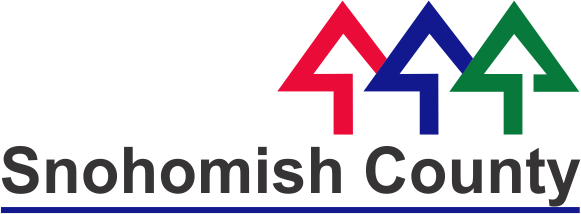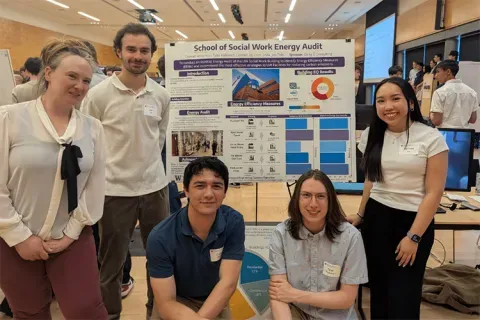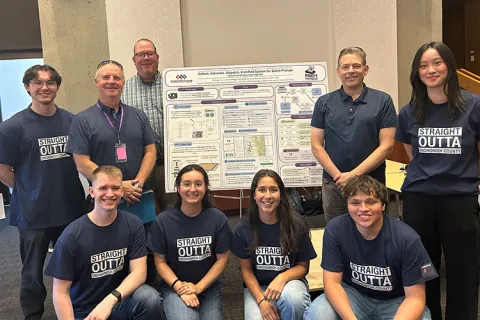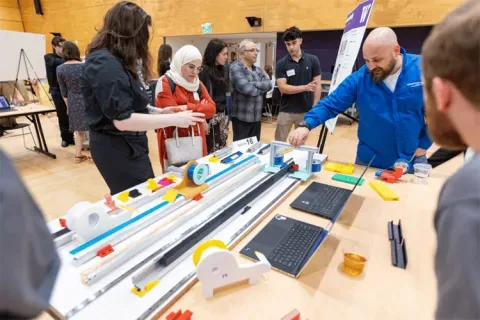Industry-Sponsored Student Capstone Projects
2022/2023
In the 2022/23 academic year the industry capstone program was supported by 56 sponsors and 99 real-world projects. Nearly five hundred and fifty students from across the College of Engineering participated. Scroll down to learn more about each project.Seagen
Infrastructure System Ownership
Seagen has a need to have a full understanding of the infrastructure systems that support their R&D and manufacturing facilities. The industry model for this to assign infrastructure systems to engineers within the Real Estate and Facilities (REF) Engineering Center of Excellence (COE). These engineers would be responsible for understanding their assigned systems. Seagen currently does not have this program developed and implemented. This has been due to limited time and resources. Seagen has extensive experience on how to establish and maintain a program like this. This student team worked to develop this program alongside Seagen’s REF Engineering COE experienced engineering staff. With Seagen engineers, this student team worked to develop a project charter, system priorities, determine which data to collect, provide data analytics direction for the monthly status meetings, and deliverables. Infrastructure systems are assigned to facilities engineers. This student team worked to: 1. Develop a charter 2. Develop building and infrastructure system priority – We will use building B8 on the North Creek (NC) site the pilot project to work through the process before taking on all sites and buildings. NC will be the manufacturing facility to implement the program after the pilot project is completed and lessons learned have been implemented into the program documentation. 3. Develop a priority of the systems to address in phases 4. Document the design basis of each system 5. Document the current available capacity for the infrastructure systems 6. Review each system for reliability risks 7. Identify future projects to mitigate the risks in item 4. 8. Propose an agreed upon frequency of review 9. Propose the format of review, KPIs to monitor, data analytics approach, BPI dashboard, etc. Anticipated outcomes this student team worked to generate include system documents that summarize: 1. Basis of design 2. Current operating parameters 3.Reliability and Risk analyses 4. Summary document for presentation to others 5. Dashboard that summarizes all the above items per system
Seattle City Light
Design a Building Electrification Demonstration Vehicle
Based on project concept input from Seattle City Light, this student team worked to create detailed design drawings and engineering for a mobile building electrification demonstration vehicle. (The scope did not include engineering of the vehicle itself, just the demonstrations on it and modifications to accommodate the demonstrations.) This student team also worked to develop a user dashboard to display system(s) data as well as interpretative text and graphics for users. The student team aimed to show technology applications that could be used in buildings, not in motor coaches, or motor homes. Anticipated outcomes this student team worked toward included: - A set of detailed drawings and images that could be turned over to a contractor to begin fabrication of this vehicle demonstration. These would include real world products such as: the heat pumps, micro-grid, battery storage, water storage, plumbing, electrical, a controls dashboard, and a vehicle that could be modified to house all of this working equipment. - Cost estimates should be provided for each component as well as a general installation costs for the entire vehicle. - A short presentation to a select group at Seattle City Light. - Graphics and text for the displays would be a bonus.

Snohomish County
Refining IT Support Delivery
Snohomish County launched a new Information Technology Service Management (ITSM) software system in December 2020. The software has integrated features, such as configurable automated work flows, urgency, escalation tiers and end user validation/ feedback surveys. After almost two years of use, Snohomish County has thousands of tickets to reference and analyze, and they are interested in further refining the configuration, and identifying common issues that 1) prompt users to reach out to IT for assistance, 2) delay Snohomish County's ability to respond as expected, and 3) create an inefficient or undesirable response. What are the investments Snohomish County should make in the product design configuration, in developing preventative efforts, or in providing end-user training that will reduce workload and align our expertise in the most effective way to meet the needs of the end user? This student team worked to spotlight patterns in system waste: configuration, end-user feedback, ticket intake and handling, ticket categories and priorities, workflows, and self-service and recommend improvements. This student team also worked to identify opportunities to proactively prevent service calls: training, resources, preventative maintenance, communication of events, etc. Finally, this student team attempted to design recommended solutions to reduce or eliminate waste and improve outcomes and assign priority to recommended improvements through measuring potential savings of time/effort, reduced wait/outage, and improved satisfaction.

Sony
Home Entertainment and Wellness
This student team worked towards improving users wellness through the use of home entertainment products in personal settings, exploring ways that home entertainment products can improve user's wellness using existing technology within their homes, and to to create use cases for home electronics in wellness. Outcomes this student team worked towards included: Use cases or frameworks Final report and presentation Notes

Starbucks
Optimize Production Capacity to Maximize Order Fulfillment
To improve partner (employee) and customer experiences, Starbucks has developed proprietary new equipment designed to meet the growing demand for customization of hot and cold beverages and warm foods. This student team worked with Starbucks' Industrial Engineering team to determine the capacity needs and deployment of this equipment for over 30,000 retail store locations worldwide. This student team sought to learn about Starbucks' new equipment and current retail operations to create a model for proposed deployment of equipment. This model was envisioned to be able to optimize the equipment's size based on sales data, forecasted growth, and equipment parameters. This student team worked to provide a summary of their findings and present them in a report.

T-Mobile
Augmented Reality Cell Site Visualization App
Reliable, high-speed internet access is becoming a necessity. However, customers lack choice and freedom with their current internet service providers and existing cable infrastructure. Wireless home internet is a growing use-case for 5G, but customers experience service issues due to suboptimal indoor home internet device placement. Compared to indoor devices, outdoor device placement offers better RF conditions. Outdoor installation also enables the use of high band mmWave frequencies due to line-of-sight requirements. Optimal outdoor installation is challenging and often requires professional installation. This student team worked to develop an augmented reality app to assist T-Mobile wireless home internet customers with indoor/outdoor device placement, give T-Mobile customers a tool to visualize the nearest cell site and antenna configuration, recommend device placement with highest predicted line of-sight to ensure an optimal home internet experience, and assist with outdoor home internet device installation challenges otherwise requiring professional help. Anticipated outcomes this student team worked towards included: - Investigation and analysis of antenna parameters and RF conditions - Understanding of wireless network architecture and RF conditions. - Trained ML model to predict RF conditions of device placement - Machine learning model training, evaluation, and deployment - Proof-of-concept augmented reality mobile app for home internet device placement - Inclusive UI/UX app design and test-driven, collaborative app development

T-Mobile
T-Mobile Wholesale Support Metrics
T-Mobile Wholesale is a Business to Business group with a complicated technical support model due to the nature of multiple systems, variable issues in locations throughout the country, and multiple engineering teams supporting the network for our customers. In Q1 of 2023, the Wholesale Customer Support Model is restructuring with a new engineering support team. This student team worked to analyze ticketing data and identify alerts for negative customer experiences. An anticipated outcome of this project was that the student team would establish alerts to the ticketing system to help T-Mobile's new engineering team identify when a potential negative customer experience may occur and when a customer services experience did not meet expectations.
Turion Space
Spacecraft Rendezvous Attachment Mechanism Testing Apparatus
This student team sought to develop and produce the initial build of a testing apparatus for space-rated attachments mechanisms purposed for Active Debris Removal (ADR) and On-orbit Service and Manufacture (OSAM) operations. The primary purpose of this system was to quantify the performance of a variety of adhesives and mechanical attachment mechanism designs in thermal vacuum (TVAC) chambers replicating a space-like environment. Specific qualities Turion seeks in this testing apparatus include a variety of surfaces, ability to test adhesion at various approach angles, and measure mechanical forces imposed on the surface in multiple directions as well as the attachment mechanism. The student team worked to rate the system to survive 10^-6 torr and temperature ranges between –40C and + 80C and to be controlled and powered via feedthroughs on standard TVAC chambers. While testing the apparatus design and the initial build were expectations Turion Space has of this student team, Turion also wanted to see the student team work to accomplish testing the apparatus.

UW Medical Center
Automated Touchless Laser Cutter for Dried Blood Spot Diagnostics
Dried blood spots (DBS) provide a convenient, patient-friendly matrix for the collection and storage of whole blood for diagnostic tests. However, excising the actual spots from the cards is a slow process and is prone to cross-contamination when contact methods such as "punching" are used. Until now, the ever-present risk of cross-contamination in contact-based processing has limited use of DBS in infectious disease testing. Touchless laser cutting of DBS eliminates this risk without compromising processing speed. Thus, this student team attempted to build a prototype user-friendly laser-cutting instrument for touchless DBS processing. This student sought to develop a small footprint lower-throughput device, (b) create plans for a larger, more automated device, and (c) generate engineering credibility and insight to successfully seek additional funding to bring the larger device to fruition.

UW Medical Center
FPGA System for RF Power Supply Control
One of the main subsystems of the cyclotron is the RF system that is responsible for generating and regulating the RF waves that create the electric field in which the particles are accelerated. One part of the RF system, the RF power supply control (RPSC), handles command, status, and interlock signals for the many power supplies in the RF system as well as their integration into the larger cyclotron control and IO system. The RPSC is still largely original components and older style of digital logic: lots of circuit cards with bulky logic gate chips and flip-flop circuits that interface with the IO system to communicate system status and if the RF system is ready to turn the beam on. For this project, the student team worked to take all those RPSC logic circuits and replace them with an FPGA based system. A modern FPGA can easily handle the various logic circuits that govern the RPSC signals. The project had two phases: first to work to identify the best FPGA platform for this project, and second to attempt to convert all the existing digital logic circuit cards into FPGA code that will run on the selected device. The redesign with an FPGA this student team worked towards aimed to clean up the RF system complexity and provide a basis to convert more of the RF system over to an FPGA system in the future. Anticipated outcomes this student team worked towards included: - A documented state-of-the-art review on FPGA platforms along with a final recommendation on which to use for this implementation and why. - Logic maps for the signals in the RPSC that represent the programming in the FPGA for future troubleshooting needs. - Full set of circuit diagrams, schematics, signal list, and written documentation of the system designed. (if applicable) - Programmed and tested FPGA system in a 19" rack that can replace the currently 18 logic circuit cards of the RPSC.
Related News

Mon, 10/13/2025 | UW Mechanical Engineering
Capstone collaboration leads to award
An ME capstone team received first place for its energy audit of the UW School of Social Work building.

Thu, 07/17/2025
UW engineering students develop smart ballot solution
UW engineering students develop smart technology solution to improve ballot collection for Snohomish County.

Mon, 07/07/2025 | UW Mechanical Engineering
Capstone creations
Students displayed innovative capstone design projects at the 2025 expo.

Fri, 09/20/2024 | UW Civil & Environmental Engineering
Smarter irrigation for a greener UW
A new project combines satellite data with ground sensors to conserve water and create a more sustainable campus environment.